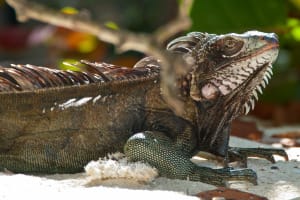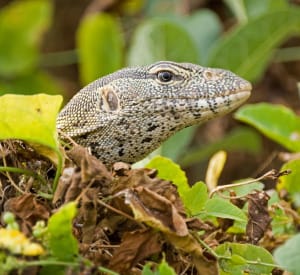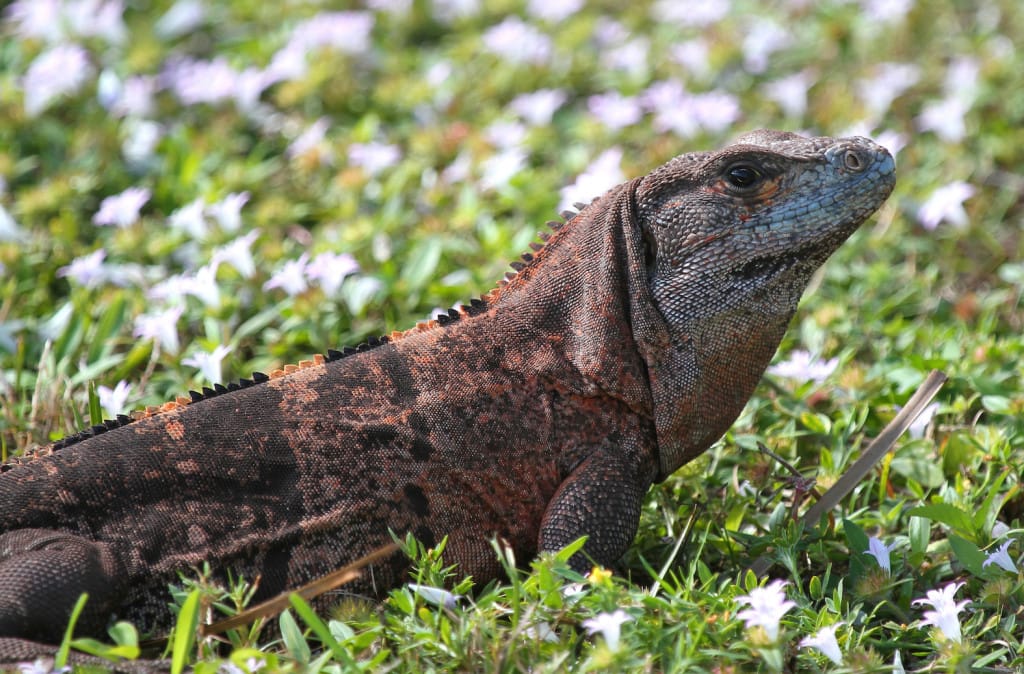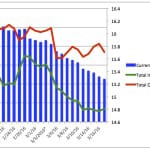Exotic Spiny-tailed Iguana Sighting Confirmed Near Beach Road On Sanibel.
As reported by City Of Sanibel News Release.
“The presence of an exotic spiny-tailed iguana (Ctenosaura sp.) was confirmed on Sanibel in the vicinity of Beach Road on December 17, 2014. This is the first documentation of a spiny-tailed iguana on Sanibel.

Green Iguana, Sanibel, File Photo By John Piekos, Via Creative Commons.
Unlike the common green iguana (Iguana iguana) which is primarily an herbivore that feeds on exotic flowers, spiny-tailed iguanas are omnivores, known to feed on flowers and vegetation but also on small vertebrates including bird and turtle eggs and may occupy burrows of other species (such as gopher tortoise).
A reproducing population of spiny-tailed iguanas could have very serious impacts on a number of the island’s native wildlife species. Unfortunately, spiny-tailed iguanas are significantly more difficult to catch/trap than the common green iguana, due to their tendency to burrow underground and/or seek shelter underneath rocks or other objects, as opposed to the arboreal (tree-living) nature of the green iguana.
To protect Sanibel’s native vegetation and wildlife populations from exotic green and spiny-tailed iguanas and to monitor for the potential presence of other exotic lizards, such as Nile monitors, the City of Sanibel is resuming the Exotic Lizard Management Program approved by City Council in 2007.
As it can be difficult even for experts to distinguish between exotic lizard species when the animals are on the move or at a distance, citizens are requested to report ANY exotic lizard sighting, 24 hours a day, seven days a week, to the Sanibel Police Department at their non-emergency number (239) 472-3111. Unless there is an imminent threat to human safety, DO NOT call 9-1-1. “
All reported sightings will be investigated by a contractual trapper for appropriate action. The trappers will be clearly identifiable in a safety green colored shirt with “Lizard Control” printed on the front and back of the shirt, as well as magnetic decals on their vehicle. Verified sightings will be mapped in order to focus management activities and track population trends.

Invasive Nile Monitor Lizard, Sanibel, File Photo By Rainer Voegeli, Via Creative Commons.
From 2007-2010, more than 2000 green iguanas and two Nile monitor lizards were removed from Sanibel. In the winter of 2010, prolonged cold temperatures were fatal to many of the remaining iguanas on Sanibel rendering the management program unnecessary. As expected, however, the green iguana population is now on the rise and, coupled with confirmation of a new exotic iguana species to Sanibel, management action is warranted. There have been no confirmed Nile monitor lizard sightings since a dead carcass was recovered from an inland lake near Rabbit Road in 2008.
If you have any questions regarding the City of Sanibel’s Exotic Lizard Management Program please contact the Natural Resources Department at (239) 472-3700. To report an exotic lizard sighting, contact the Sanibel Police Department non-emergency number at (239) 472-3111.”
Spiny-tailed Iguana File Photo (Ctenosaura similis) by J.D. Willson, Via Creative Commons.











